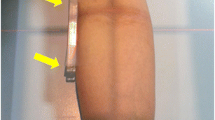Abstract
Background
Overstuffing of the radiocapitellar joint during metallic radial head arthroplasty has been reported to cause loss of elbow flexion, capitellar erosion, and early-onset osteoarthritis. Although this is known, there is no agreed-on measurement approach to determine whether overstuffing has occurred.
Questions/purposes
We therefore hypothesized that overlengthening the radial head during radial head arthroplasty changes the ulnar variance in the wrist.
Methods
Seven cadaveric radii were implanted with radial head prostheses of increasing thickness. Each specimen was implanted successively with increasingly thick radial head prostheses measuring 2, 4, and 6 mm thicker than the native radial head, and radiographs were taken after implantation of each prosthesis. The ulnar variance with each prosthesis was measured using the method of perpendiculars.
Results
The ulnar variance of the native and 2-mm (p = 0.04), 4-mm (p = 0.008), and 6-mm (p = 0.008) overly thick radial head prosthesis-implanted states decreased significantly with each incremental increase in prosthetic head thickness.
Conclusions
Implantation of thicker radial head prostheses decreased the ulnar variance. Our results indicate ulnar variance could be used to detect overstuffing of radial head prostheses.
Clinical Relevance
The simplicity and reliability of ulnar variance make it a potentially useful indicator of overlengthening after radial head arthroplasty.





Similar content being viewed by others
References
Athwal GS, Frank SG, Grewal R, Faber KJ, Johnson J, King GJ. Determination of correct implant size in radial head arthroplasty to avoid overlengthening: surgical technique. J Bone Joint Surg Am. 2010;92(Suppl 1):250–257.
Birkedal JP, Deal DN, Ruch DS. Loss of flexion after radial head replacement. J Shoulder Elbow Surg. 2004;13:208–213.
Coleman DA, Blair WF, Shurr D. Resection of the radial head for fracture of the radial head: long-term follow-up of seventeen cases. J Bone Joint Surg Am. 1987;69:385–392.
De Smet L. Ulnar variance: facts and fiction review article. Acta Orthop Belg. 1994;60:1–9.
Doornberg JN, Linzel DS, Zurakowski D, Ring D. Reference points for radial head prosthesis size. J Hand Surg Am. 2006;31:53–57.
King GJ, Zarzour ZD, Rath DA, Dunning CE, Patterson SD, Johnson JA. Metallic radial head arthroplasty improves valgus stability of the elbow. Clin Orthop Relat Res. 1999;368:114–125.
Moon JG, Southgate RD, Fitzsimmons JS, O’Driscoll SW. Simple overlay device for determining radial head and neck height. Skeletal Radiol. 2010;39:915–920.
Pomianowski S, Morrey BF, Neale PG, Park MJ, O’Driscoll SW, An KN. Contribution of monoblock and bipolar radial head prostheses to valgus stability of the elbow. J Bone Joint Surg Am. 2001;83:1829–1834.
Rowland AS, Athwal GS, MacDermid JC, King GJ. Lateral ulnohumeral joint space widening is not diagnostic of radial head arthroplasty overstuffing. J Hand Surg Am. 2007;32:637–641.
Shors HC, Gannon C, Miller MC, Schmidt CC, Baratz ME. Plain radiographs are inadequate to identify overlengthening with a radial head prosthesis. J Hand Surg Am. 2008;33:335–339.
Shrout PE, Fleiss JL. Intraclass correlations: uses in assessing rater reliability. Psychol Bull. 1979;86:420–428.
Steyers CM, Blair WF. Measuring ulnar variance: a comparison of techniques. J Hand Surg Am. 1989;14:607–612.
Van Glabbeek F, Van Riet RP, Baumfeld JA, Neale PG, O’Driscoll SW, Morrey BF, An KN. Detrimental effects of overstuffing or understuffing with a radial head replacement in the medial collateral-ligament deficient elbow. J Bone Joint Surg Am. 2004;86:2629–2635.
Van Glabbeek F, van Riet RP, Baumfeld JA, Neale PG, O’Driscoll SW, Morrey BF, An KN. The kinematic importance of radial neck length in radial head replacement. Med Eng Phys. 2005;27:336–342.
van Riet RP, van Glabbeek F, de Weerdt W, Oemar J, Bortier H. Validation of the lesser sigmoid notch of the ulna as a reference point for accurate placement of a prosthesis for the head of the radius: a cadaver study. J Bone Joint Surg Br. 2007;89:413–416.
Author information
Authors and Affiliations
Corresponding author
Additional information
Each author certifies that he or she, or a member of his or her immediate family, has no commercial associations (eg, consultancies, stock ownership, equity interest, patent/licensing arrangements, etc) that might pose a conflict of interest in connection with the submitted article.
All ICMJE Conflict of Interest Forms for authors and Clinical Orthopaedics and Related Research editors and board members are on file with the publication and can be viewed on request.
Clinical Orthopaedics and Related Research neither advocates nor endorses the use of any treatment, drug, or device. Readers are encouraged to always seek additional information, including FDA-approval status, of any drug or device prior to clinical use.
Each author certifies that his or her institution approved or waived approval for the human protocol for this investigation and that all investigations were conducted in conformity with ethical principles of research.
About this article
Cite this article
Moon, JG., Hong, JH., Bither, N. et al. Can Ulnar Variance Be Used to Detect Overstuffing After Radial Head Arthroplasty?. Clin Orthop Relat Res 472, 727–731 (2014). https://doi.org/10.1007/s11999-013-3277-z
Received:
Accepted:
Published:
Issue Date:
DOI: https://doi.org/10.1007/s11999-013-3277-z




